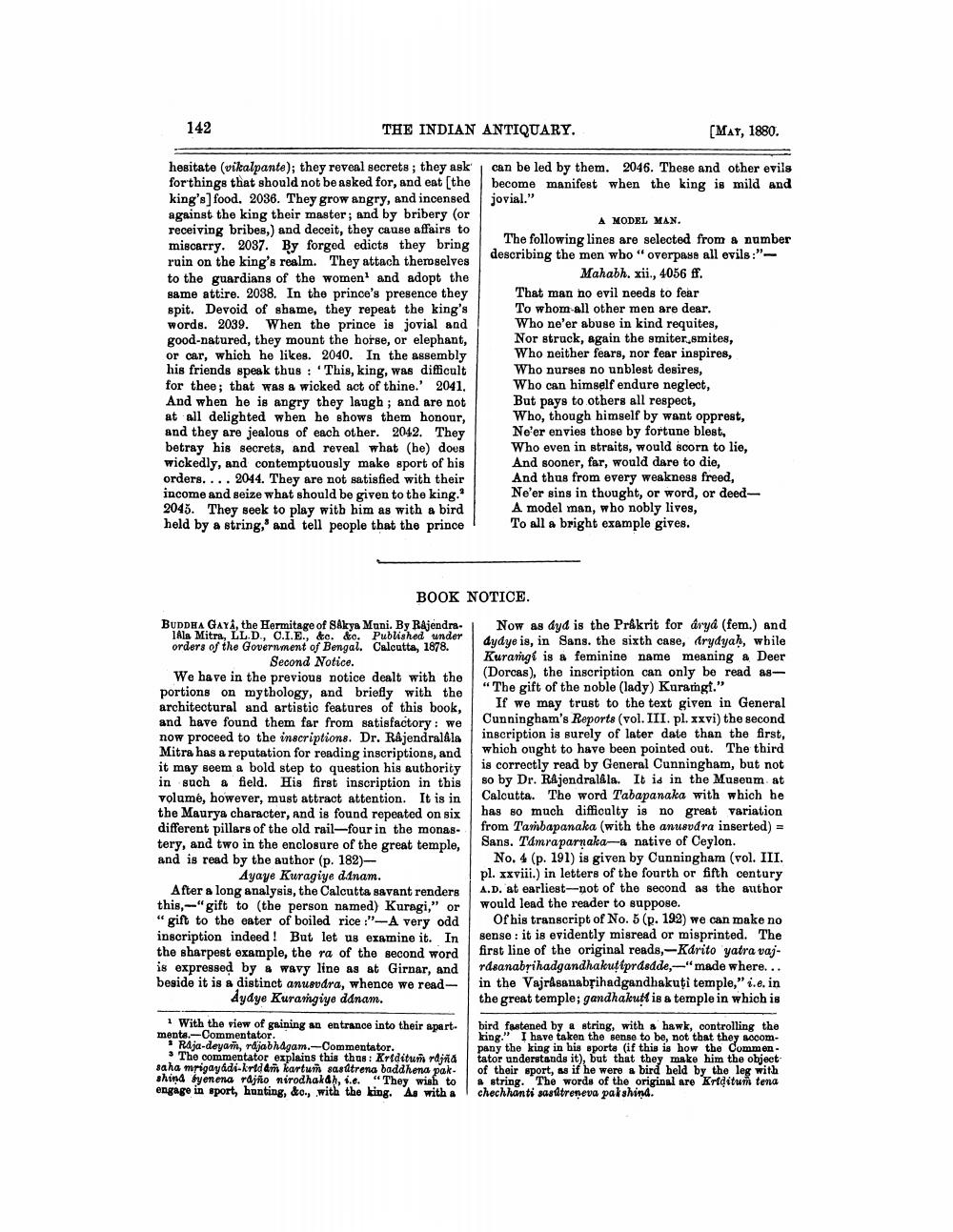________________
142
THE INDIAN ANTIQUARY.
[MAT, 1880.
hesitate (vikalpante); they reveal secrets; they ask forthings that should not be asked for, and eat (the king's) food. 2036. They grow angry, and incensed against the king their master; and by bribery (or receiving bribes,) and deceit, they cause affairs to miscarry. 2037. By forged edicts they bring ruin on the king's realm. They attach theroselves to the guardians of the women and adopt the same attire. 2038. In the prince's presence they spit. Devoid of shame, they repeat the king's words. 2039. When the prince is jovial and good-natured, they mount the horse, or elephant, or car, which he likes. 2040. In the assembly his friends speak thus : This, king, was difficult for thee; that wAS & wicked act of thine.' 2041, And when he is angry they laugh; and are not at all delighted when he shows them honour, and they are jealous of each other. 2042. They betray his secrets, and reveal what (he) does wickedly, and contemptuously make sport of his orders. ... 2044. They are not satisfied with their income and seize what should be given to the king. 2045. They seek to play with him as with a bird held by a string,' and tell people that the prince
can be led by them. 2046. These and other evils become manifest when the king is mild and jovial."
A MODEL MAN. The following lines are selected from a number describing the men who "overpase all evils:"
Mahabh. xii., 4056 ff. That man no evil needs to fear To whom all other men are dear, Who ne'er abuse in kind requites, Nor struck, again the smiter,smites, Who neither fears, nor fear inspires, Who nurses no unblest desires, Who can himself endure neglect, But pays to others all respect, Who, though himself by want opprest, Ne'er envies those by fortune blest, Who even in straits, would scorn to lie, And sooner, far, would dare to die, And thus from every weakness freed, Ne'er sins in thought, or word, or deed A model man, who nobly lives, To all a bright example gives.
BOOK NOTICE.
BUDDHA GAYA, the Hermitage of Sakya Muni. By Rajendra
Als Mitra, LL.D., O.I.E., &c. &c. Published under orders of the Government of Bengal. Calcutta, 1878.
Second Notice.
We have in the previous notice dealt with the portions on mythology, and briefly with the architectural and artistic features of this book, and have found them far from satisfactory: we now proceed to the inscriptions. Dr. Rajendraldla Mitra has a reputation for reading inscriptions, and it may seem a bold step to question his authority in such a field. His first inscription in this volumé, however, must attract attention. It is in the Maurya character, and is found repeated on six different pillars of the old rail-four in the monastery, and two in the enclosure of the great temple, and is read by the author (p. 182)
Ayaye Kuragiye dinam. After a long analysis, the Calcutta savant renders this.--"gift to the person named) Kuragi," or " gift to the eater of boiled rice:"-A very odd inscription indeed! But let us examine it. In the sharpest example, the ra of the second word is expressed by & wavy line as at Girnar, and beside it is a distinct anuevdra, whence we read
Aydye Kurangiye ddnam.
Now as dyd is the Prakrit for arya (fem.) and dydye is, in Sans. the sixth case, drydyah, wbile Kurangi is a feminine name meaning a Deer (Dorcas), the inscription can only be read as"The gift of the noble (lady) Kurangi."
If we may trust to the text given in General Cunningham's Reports (vol. III. pl. xxvi) the second inscription is surely of later date than the first, which onght to have been pointed out. The third is correctly read by General Cunningham, but not so by Dr. Rajendraldla. It is in the Museum at Calcutta. The word Tabapanaka with which he has so much difficulty is no great variation from Tambapanaka (with the anusudra inserted) = Sans. Tamraparnaka-a native of Ceylon.
No. 4 (p. 191) is given by Cunningham (vol. III. pl. xxviii.) in letters of the fourth or fifth century A.D. at earliest-not of the second as the author would lead the reader to suppose.
of his transcript of No. 5 (p. 192) we can make no sense : it is evidently misread or misprinted. The first line of the original reads,-Karito yatra vajrdsanabrihadgandhakutiprdedde,-"made where... in the Vajrásanabrihadgandhakuti temple," i.e.in the great temple; gandhakutt is a temple in which is
1 With the view of gaining an entrance into their apart. mente.-Commentator.
Raja-deyam, rdjabhagam.- Commentator.
The commentator explains this thus: Kreditun rajna saha mrigayadi-kridan kartu sasttrena baddhena pak. shind byenena rdjito nirodhakah, i.e. "They wish to engage in sport, hunting, &o., with the king. As with a
bird fastened by a string, with a hawk, controlling the king." I have taken the sense to be, not that they sooompany the king in his sporta (if this is how the commentator understands it), but that they make him the objectof their sport, as if he were a bird held by the leg with & string. The words of the original are Kridituí tena chechhanti susitreneva pakshind.




